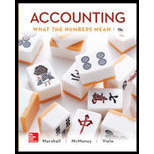
Concept Introduction:
Operating Income
It is the net income of the entity without including the impact of any financial activity or taxed. It measures entity's ability to generate earnings from its operational activities. It can be calculated using the following equation:
Variable expenses
The expenses which are associated with the amount of goods produced or services provided. These vary directly with the production level i.e. company's variable cost increases as the production increases and vice-a-versa.
Fixed expenses
These expenses do not vary with the level of production. They do not change with the amount of goods or services a company produces. They remain same even if the company does not produce any product or provide any service during an accounting period.
Requirement a:
To calculate:
Operating income of May
Concept Introduction:
Contribution margin
It is the difference between total revenue and variable expenses. Contribution margin equals the amount that sales exceed variable costs. It measures how efficiently a company can produce products and maintain low levels of variable cost.
Contribution margin, when expressed in percentage form is known as Contribution margin ratio and can be calculated as follows:
Variable expenses
The expenses which are associated with the amount of goods produced or services provided. These vary directly with the production level i.e. company's variable cost increases as the production increases and vice-a-versa.
Requirement b:
To calculate:
Break- even point in terms of units sold and total revenues
Concept Introduction:
Operating Income
<[>It is the net income of the entity without including the impact of any financial activity or taxed. It measures entity's ability to generate earnings from its operational activities. It can be calculated using the following equation:
Variable expenses The expenses which are associated with the amount of goods produced or services provided. These vary directly with the production level i.e. company's variable cost increases as the production increases and vice-a-versa.
Fixed expenses
These expenses do not vary with the level of production. They do not change with the amount of goods or services a company produces. They remain same even if the company does not produce any product or provide any service during an accounting period.
Requirement c:
- Operating income with new cost structure
- Break- even point in units with new cost structure
- Reason for suggestion of investing in automated equipment and accept new cost structure
- Reasons if management does not accept recommendation
Want to see the full answer?
Check out a sample textbook solution
Chapter 12 Solutions
Accounting: What the Numbers Mean
- I am trying to find the accurate solution to this general accounting problem with the correct explanation.arrow_forward← Week 1: Homework Question 3 of 4 8.75/10 The project is completed in 2025, and a successful patent is obtained. The R&D costs to complete the project are $113,000. The administrative and legal expenses incurred in obtaining patent number 472-1001-84 in 2025 total $16,000. The patent has an expected useful life of 5 years. Record the costs for 2025 in journal entry form. Also, record patent amortization (full year) in 2025. (Credit account titles are automatically indented when amount is entered. Do not indent manually. If no entry is required, select "No Entry" for the account titles and enter O for the amounts. List all debit entries before credit entries.) Account Titles and Explanation Research and Development Expense Cash (To record research and development costs) Patents Cash (To record legal and administrative costs) Amortization Expense Patents (To record one year's amortization expense) Debit 113000 16000 3200 Credit 113000 16000 3200arrow_forwardJoe transfers land to JH Corporation for 90% of the stock in JH Corporation worth $20,000 plus a note payable to Joe in the amount of $40,000 and the assumption by JH Corporation of a mortgage on the land in the amount of $100,000. The land, which has a basis to Joe of $70,000, is worth $160,000. a. Joe will have a recognized gain on the transfer of $90,000. b. Joe will have a recognized gain on the transfer of $30,000.c. JH Corporation will have a basis in the land transferred by Joe of $70,000. d. JH Corporation will have a basis in the land transferred by Joe of $160,000. e. None of the above.arrow_forward
- Please provide the correct answer to this general accounting problem using accurate calculations.arrow_forwardCan you solve this general accounting question with accurate accounting calculations?arrow_forwardCan you help me solve this general accounting question using valid accounting techniques?arrow_forward
- Can you help me solve this general accounting problem with the correct methodology?arrow_forwardI need assistance with this general accounting question using appropriate principles.arrow_forward(1) prepare the december 31 entry for bramble corporation to record amortization of intangibles. the trademark has an estimated useful life of 4 years with a residual value of $3,520arrow_forward

 AccountingAccountingISBN:9781337272094Author:WARREN, Carl S., Reeve, James M., Duchac, Jonathan E.Publisher:Cengage Learning,
AccountingAccountingISBN:9781337272094Author:WARREN, Carl S., Reeve, James M., Duchac, Jonathan E.Publisher:Cengage Learning, Accounting Information SystemsAccountingISBN:9781337619202Author:Hall, James A.Publisher:Cengage Learning,
Accounting Information SystemsAccountingISBN:9781337619202Author:Hall, James A.Publisher:Cengage Learning, Horngren's Cost Accounting: A Managerial Emphasis...AccountingISBN:9780134475585Author:Srikant M. Datar, Madhav V. RajanPublisher:PEARSON
Horngren's Cost Accounting: A Managerial Emphasis...AccountingISBN:9780134475585Author:Srikant M. Datar, Madhav V. RajanPublisher:PEARSON Intermediate AccountingAccountingISBN:9781259722660Author:J. David Spiceland, Mark W. Nelson, Wayne M ThomasPublisher:McGraw-Hill Education
Intermediate AccountingAccountingISBN:9781259722660Author:J. David Spiceland, Mark W. Nelson, Wayne M ThomasPublisher:McGraw-Hill Education Financial and Managerial AccountingAccountingISBN:9781259726705Author:John J Wild, Ken W. Shaw, Barbara Chiappetta Fundamental Accounting PrinciplesPublisher:McGraw-Hill Education
Financial and Managerial AccountingAccountingISBN:9781259726705Author:John J Wild, Ken W. Shaw, Barbara Chiappetta Fundamental Accounting PrinciplesPublisher:McGraw-Hill Education





